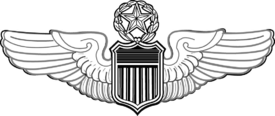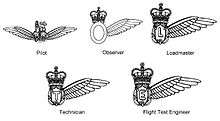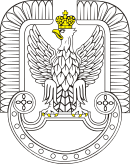Aviator badge
An aviator badge is an insignia used in most of the world's militaries to designate those who have received training and qualification in military aviation. Also known as a Pilot’s Badge, or Pilot Wings, the Aviator Badge was first conceived to recognize the training that military aviators receive, as well as provide a means to outwardly differentiate between military pilots and the “foot soldiers” of the regular ground forces.
United States
| United States Aviator Badge | |
|---|---|
 | |
| Awarded by United States Armed Forces | |
| Type | Badge |
| Status | Currently awarded |
| Statistics | |
| Established | Second World War |
| First awarded | Second World War |
| Last awarded | On going |
| Army Precedence | |
| Next (higher) | Military Free Fall Parachutist Badge |
| Next (lower) | Astronaut Device[1] |
A United States Aviator Badge refers to three types of aviation badges issued by the United States military, those being for Army, Air Force, and Naval aviation.
In the modern military, Army and Air Force Aviator Badges are issued in three ratings: Basic, Senior, and Command/Master/Chief. The higher degrees are denoted by a star or star with wreath above the badge. Air Force regulations state that the basic rating denotes completion of specified training and that the advanced ratings denote experience levels. The Naval Aviator Badge is issued in a single rating for the Navy, Marine Corps, and Coast Guard.
United States Army
World War I
The first United States Aviator Badges were issued to members of the Air Service during World War I. The badges were issued in three degrees: Observer (a "US" shield and one left-side wing), Junior Aviator or Reserve Aviation Officer (a "US" shield between two wings), and Senior Aviator (a star over "US" shield between two wings). The Army Air Corps also issued a badge for balloon pilots, known as the Aeronaut Badge.
Enlisted Aviators wore their regular rank insignia and the Observer's badge. There were 29 enlisted pilots before the American entry into World War I. The second enlisted aviator, William A. Lamkey, got a discharge and flew for Pancho Villa. The remaining enlisted pilots received commissions in 1917. There were 60 enlisted mechanics who were trained as pilots in France during the war, but they were used for ferrying duties and did not fly in combat.[2] The recruiting and training of enlisted Aviators ended in 1933.
World War II

During World War II, with the rise of the Army Air Forces, a second series of aviator badges were issued to include a design that has survived to the modern day. The Army Air Corps Pilot Badge was issued in three degrees, including Pilot, Senior Pilot, and Command Pilot. A polished silver colored version of these badges is currently used as the United States Air Force Pilot Badges.
From August 1941 to November 1942, the Enlisted Aviator program was restarted. Candidates had to be at least 18, possess a high school diploma, and have graduated at the top of their High School class. Graduates were rated as Flight Staff Sergeants or Flight Technical Sergeants and wore the same pilot's wings as officers. They were usually assigned to pilot transport and auxiliary aircraft to free officer pilots to pilot the more prestigious fighters and bombers. Auxiliary pilots received their own special wings to indicate their status and specialty. In November 1942 all enlisted pilots were promoted to Flight Officer rank and enlisted cadets were graded as Flight Officers or Second Lieutenants depending on merit.


Cold War
After the creation of the U.S. Air Force as a separate service in 1947, Army Aviation continued to a degree that warranted a new badge for Army Aviators. The result was the creation of the Army Aviator Badge, which is a modified version of the U.S. Air Force Pilot Badge. It comes in three grades: Basic, Senior (7 years service and 1,000 flight hours), and Master (15 years service and 2,000 flight hours).[3] The Aviator and Senior Aviator Badges were approved on 27 July 1950 and the Master Aviator Badge was approved on 12 February 1957.
United States Air Force
In 1947, the U.S. Army Air Corps-cum-U.S. Army Air Forces became its own separate service as the U.S. Air Force. The Air Force use the same pilot's badges as the earlier USAAC / USAAF design except that starting in the mid-1990s, they began to be made of chrome metal or sterling silver rather than the dull alloy wings used by the Army or the Air Force from 1947 to the mid-1990s. The U.S. Air Force currently issues several aviation badges including pilot, combat systems officer (formerly navigator), air battle manager, flight surgeon, flight nurse, non-rated officer aircrew, and enlisted aircrew. The requirements to earn these are listed here.
United States Navy, Marine Corps and Coast Guard
The aviator badge currently used in the Navy has remained virtually unchanged since it was first issued on 13 November 1917. The Naval Aviator Badge is earned by all U.S. Navy, U.S. Marine Corps, and U.S. Coast Guard pilots upon graduation from advanced flight training. Additional aviator badges exist for Naval Flight Officers (USN & USMC), Naval Flight Surgeons, Naval Aviation Physiologists, Naval Flight Nurses, Naval Aviation Observers (USN & USMC) and enlisted Naval Aircrewman (USN, USMC & USCG). Naval Aviators' badges are gold in color. Unlike the Air Force and the Army, the naval services do not employ senior or command/master aeronautical ratings.

NOAA Commissioned Corps
The NOAA Commissioned Corps Aviator Insignia is a gold-colored pin, winged, with a central device consisting of a fouled anchor surcharged with a NOAA Corps device. NOAA Corps officer pilots and navigators may wear the NOAA aviator insignia after authorization by the Director of the NOAA Corps.

NASA
With the dawn of the Space Age, all of the United States Aviator badges are upgradable to the Astronaut Badge, for those military members who become astronauts.
British Commonwealth
The current aviator badge of the Royal Air Force has been in use since the Second World War. The badge consists of a winged crown and wreath, beneath which are the letters "RAF". The Royal Air Force also uses a "half wing" version to denote Aviation Observers. An aircrew brevet (officially known as an aircrew badge) is the badge worn on the left breast, above any medal ribbons, by qualified aircrew in the Royal Air Force, British Army, Indian Air Force, Pakistan Air Force, Royal Canadian Air Force, Australian Army, Royal Australian Air Force, Royal New Zealand Air Force, South African Air Force and Sri Lanka Air Force.
United Kingdom
Royal Air Force
.jpg)
In the RAF, aircrew 'wings' are awarded upon the completion of a significant stage of flying training. Aircrew first undertake Elementary Flying Training, and are then streamed to either fast jet, helicopter or multi-engine pipelines. The award of wings usually occurs upon completion of the secondary phase of training; for example, in the fast jet stream, wings are awarded upon completion of the Basic Fast Jet Course (BJFT), currently at RAF Linton-on-Ouse; for helicopter pilots, wings are awarded after they complete helicopter training at RAF Shawbury pre-OCU, and for multi-engine aircrew, wings are awarded upon completion of their Multi-Engine Advanced Flying Training (MEAFT) training at RAF Cranwell. Aircrew therefore are posted to their Operational Conversion Units having gained their wings, but they still have a good deal of training and type familiarisation to complete before they are considered operational or front-line aircrew.

Pilots wear the letters "RAF" in a brown wreath, surmounted by a crown, with a swift's wing on each side. UAV pilots have similar wings except with a light blue wreath. From April 2003, weapons systems officers/operators are awarded a similar brevet with a single wing. Other aircrew wear a letter or letters (denoting speciality) in a wreath, with a single wing. The only other brevets currently worn are "E" (air engineer), "AT" (airborne technician), "IA" (imagery analyst) and "FC" (fighter controller). Parachute Jumping Instructors (PJIs) wear an open parachute instead of a letter. "AS" (air steward) was replaced with a brevet with "CC" (cabin crew); this brevet is unusual for aircrew as it is worn on the right sleeve in the same location as parachute qualification, has two up turned wings (similar to Royal Navy ratings' aircrewman badges) and has cream stitching for the wings, lettering and laurels (other brevets have bronze or blue laurels).
Previous brevets
Brevets prior to 2003 (when roles became represented by the single WSO brevet) include "N" (navigator), "LM" (air loadmaster), "AE" (air electronics operator), "B" (bomb aimer), "AG" (air gunner), "AS" (air steward) (replaced by "Cabin Crew"), "M" (meteorological observer), "QM" (air quartermaster), "S" (air signaller), and "RO" (radio observer). Observers wore a single wing attached directly to the letter "O". Some of these now obsolete brevets can still be worn (LM, E, S, AS and AE) by serving aircrew however, provided it was the brevet with which they were initially awarded, with the exception of the Observer's brevet which was replaced by the Navigator's brevet in 1942. AG and B have also been obsolete for several decades, where as M and QM were phased out in the 1970s or 1980s.
Royal Navy

The Royal Navy's Fleet Air Arm has its own wings design, featuring albatross wings instead of the wings of a swift, as per the RAF design. The Fleet Air Arm wings badges feature albatross wings, a crown and anchor, reflecting the naval aspect of the flying undertaken. They are worn on the sleeve of naval aviators, above the rank "rings" as opposed to on the left breast of RAF uniforms. Unlike the RAF and the Army Air Corps, Naval aircrew are awarded their wings after OCU, whereupon they are posted to a frontline squadron, the majority of their flying training complete. Therefore, while a Navy and RAF aircrew might take a similar amount of time to reach an operational squadron, the Naval officer has to wait until he has completed his conversion training to receive his wings.
Naval Observers are awarded their own aircrew brevet, consisting of shorter wings either side of a fouled anchor surmounted by a Crown, upon completion of their Observer training at 750 NAS at RNAS Culdrose. Naval Aircrewmen are awarded a brevet similar in shape to the 'Cabin Crew' brevet of the RAF, with upturned wings and a similar Anchor & Crown design to Observers. These badges are also worn on the sleeve of the Number 1 dress uniform jacket, above any rank insignia.
British Army

The Army Air Corps pilot wings are awarded upon completion of the basic helicopter course at RAF Shawbury and a subsequent Army course at Middle Wallop Airfield. Aircrew are then dispatched to their OCU to receive type training on either the Apache attack helicopter or the Wildcat battlefield support helicopter. A small number of Army aircrew are streamed fixed wing to fly the Army's Islander/Defender reconnaissance aircraft, or to become instructors at the Defence Elementary Flying School on the Tutor training aircraft.
The Army is unique in the British military in that both Officers and Non-Commissioned Officers can become aircrew and aircraft commanders. The wings are identical for both Officers and Other Ranks, and are worn on the left chest above any medals, similar to the RAF.
It should be noted that in all the services, award of wings does not confer any operational capability - this is declared by an front-line squadron once the student has reached satisfactory standard to allow them to be deployed operationally. This milestone, or'Combat Ready Status', is the threshold necessary for the award of Flying Pay, a discretionary additional salary bonus for aircrew due to the nature of their work.
Australia

Royal Australian Air Force brevets differ from those in the RAF mainly in having a crown on all brevets (not just on pilot's wings) and in normally having blue wreaths. The pilot's brevet has the letters "RAAF". A similar twin-wing brevet, bearing the Southern Cross, was introduced for officer aircrew in 1998, replacing various single-wing brevets previously worn by commissioned officers;[4] however NCO aircrew continue to wear the old single-wing brevets.
Most RAAF pilots signed a petition in 1998/1999 in protest of non-pilot "officer aircrew" receiving a double wing. For the most part this was supported by serving navigators and war veterans who had previously held the soon to be abolished 'half' wing. The petition ultimately had over 10,000 signatures, but in the end the petition was unsuccessful.[5]

New Zealand
New Zealand uses similar insignia to the United Kingdom, except the pilot's wings bear the letters "NZ" instead of "RAF" and the single wing of other aircrew still have the letters of the trade they represent. Currently these are air warfare officer and specialist (AW), air engineer (E), air loadmaster (LM), helicopter loadmaster (HL), flight steward (FS), air ordnanceman (AO), and parachute jump instructor (a parachute). Air electronics operator (AE) and Helicopter crewman (HC) is obsolete.
Belgium
The current aviator badge of the Belgian Air Force is:

Denmark
The aviator badge of the Royal Danish Air Force is:

Germany
1935–1945

The Pilotenabzeichen (Pilot's Badge) of the former Luftwaffe had been instituted by Hermann Göring on 12 August 1935. It came in distinct types; nickel silver (changed to zinc during the war) and a variant made of gold.[6] It depicts a silver eagle (Silberner Adler) perched atop a swastika (Hakenkreuz), wings open in a landing pose, and surrounded by a wreath with laurel (Lorbeer) on the right side and oak (Eichenlaub) branches on the left side, respectively.[7] It was worn in the center of the left breast pocket of the service tunic, underneath the Iron Cross 1st Class if awarded.[8] The badge was awarded after one completed flight training and the flying licence and citation were received.[7]
After 1955

In the Bundeswehr the aviation badge (Tätigkeitsabzeichen Militärluftfahrzeugführer) comes in three grades: bronze (Standard Pilot), silver (Senior Pilot) after 1200 flight hours and gold (Command Pilot) after 1800 flight hours. It depicts the Bundesadler surrounded by an oak leaf wreath between two wings. It is worn above the right breast pocket. A total of two Tätigkeitsabzeichen may be worn, one of which can be foreign in which case the foreign one would be worn below the German one.[9]
Hungary
1938-1945
Pilots and navigators of the Royal Hungarian Air Force wore their aviator rating badge sawn on their uniforms right breast above the pocketflap. The Observers Badge was the same, except without the Holy Crown of Hungary. A smaller version of the pilot’s badge which was worn on the lower left sleeve of the overcoat - observers also worn a small insignia without the srown on their sleeve.[10] During the World War II a goldified bronze pilot and observer badge was also introduced.
 Royal Hungarian Air Force Pilots Badge sawn version |
 Royal Hungarian Air Force Pilots Badge metal version |
 Royal Hungarian Air Force Observers Badge metal version |
After 1990
After the withdrawal of Soviet forces from Hungary a new Hungarian Air Force was created. It took on the tradititons of the Royal Hungarian Air Force. There are 4 classes of pilots badges. Gold laurel 1st class aviator; 1st class aviator, 2nd class aviator, and 3rd class aviator.

 1st class aviator badge |
 2nd class aviator badge |
 3rd class aviator badge |
Israel
The current badge of a pilot in the Israeli defense forces is:

Namibia
The aviator badge of the Namibian Air Force is:

The Netherlands
The aviator badge of the Royal Netherlands Air Force and the Royal Netherlands Navy is:

Poland
The current aviator badge of the Polish Air Force has been in use since the 1920s. The badge is called gapa and represents silver eagle in flight with gold laurel wreath in the bill. Navigator/Observer badge (below) represents the same eagle, but in gold with added lightning bolts. It is unlike any other in the other air forces in the world. The gapa was worn in the usual place on the upper left breast above the pocket, but with a chain. It proudly adorned the uniform of Polish Air Force officers in the RAF during World War II along with their RAF wings. In combat badges (for at least 7 flights in combat conditions) the laurel wreath is green.
| Badge | Pilot | Pilot | Observer | ||||||
|---|---|---|---|---|---|---|---|---|---|
 Air Forces |
 |
|
 | ||||||
| Pilot | Pilot | Observer | |||||||
| Abbreviation | pil. | pil. | obs. | ||||||
South Africa

The current aviator badge of the South African Air Force has been in use since 2002, when South Africa adopted a new coat of arms. Like the RAF, the SAAF also has a half-wing version of the badge, in this case for navigators. The aviator and navigator badges comes in three grades: bronze, silver and gold. Reserve force aviator badges have a light blue inlay around the coat of arms as appose to the dark blue of permanent air force aviators.
Spain


Turkey

Notes
- ↑ Army Regulation 600-8-22 Military Awards (24 June 2013). Table 8-1, U.S. Army Badges and Tabs: Orders of precedence. p. 120
- ↑ http://www.nationalmuseum.af.mil/factsheets/factsheet.asp?id=1427
- ↑ http://www.ljmilitaria.com/armypatches/u__s__army_aviation_wings_and_misc__.htm#badges_1
- ↑ "Brevets signal start". Air Force News. 48 (14). 10 August 2006. Retrieved 7 December 2015.
- ↑ "ID Badges Used in War History". idcardkits.com. 2015. Archived from the original on 5 March 2016. Retrieved 7 December 2015.
- ↑ Ailsby 2003, pp. 59, 60.
- 1 2 Ailsby 2003, p. 59.
- ↑ Angolia 1987, p. 162.
- ↑ ZDv 37/10 Anzugordnung für die Bundeswehr
- ↑ http://members.shaw.ca/czink/index_files/images/MARCH%20APRIL%202003.pdf
References
- Ailsby, Christopher (2003) [1994]. A Collector's Guide To: World War 2 German Medals and Political Awards. Ian Allan Publishing, Inc. ISBN 9780711021464.
- Angolia, John (1987). For Führer and Fatherland: Military Awards of the Third Reich. R. James Bender Publishing. ISBN 0912138149.


